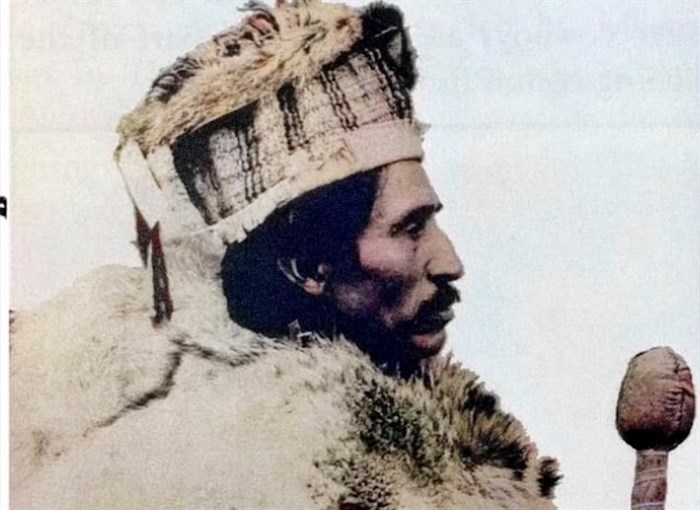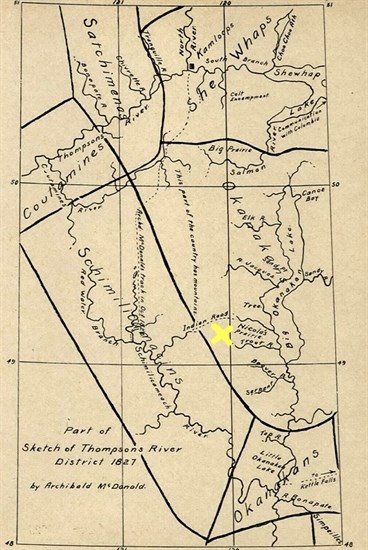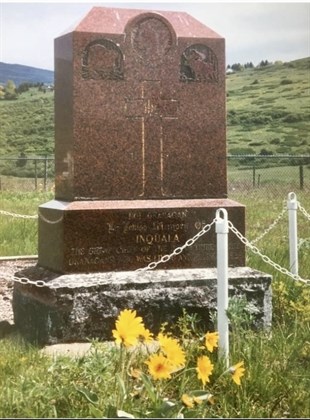
There is no known photo of Hwistesmexe’qen. However he is assumed to have looked similarly to this.
Image Credit: SUBMITTED/ David Gregory
October 28, 2023 - 6:00 AM
After weeks of searching for an Indigenous historian who could tell me the story of Grand Chief Nicola, I was thrilled when I was given the contact of one of his direct descendants. Skyaka, otherwise known by his English name, Bruce Manuel.
I called Skyaka' and he asked me to tell him what I knew about the famous Chief. He waited silently on the other end of the phone as I recounted what I knew of Nicola’s history.
Skyaka’ explained his trepidation. But after a lengthy explanation of why I wanted to write the story, he was seemingly convinced. We organised to meet the following Tuesday at the En'owkin Centre in Penticton.
Before we sat down to talk, Skyaka’ gave me a tour of the centre. I followed behind him as he showed me the various libraries, recording studios and offices where staff and students were working to immortalize and transcribe the Nsylixcen language.
Student artworks hung on every wall. Skyaka' stopped to explain what story was being told in the paintings, who was represented and what it meant.
Around the perimeter of the large meeting room were two traditional canoe boats and in the centre stood four tall wooden pillars in a square.
Different images were engraved into the wood of each pole. They represented the four food chiefs, Skyaka’ explained. The Bear, the Salmon, the Bitterroot and the Saskatoon. The pillars were riding on the back of a large turtle carved into the floor beneath our feet.
Skyaka’ pulled out a chair for me at a table beside the pillars. I thanked him for wanting speak to me. He reminded me that he didn't and we laughed.
The stories of the Okanagan peoples have been historically altered by white settlers, he explained. The true story of Chief Nicola has rarely been told.
The Chief is an almost mythical figure in Okanagan folklore, famous for his unification of various Indigenous nations and for his supposed role as peace maker during early European settlement.
But this isn't the Syilx story, Skyaka explained, and 'Grand Chief Nicola' wasn't his name.
The Chief’s name was Hwistesmexe’qen, pronounced “N-hoist-tem-mee-can” which translates to “female grizzly standing upright.” Skyaka' said this was an important name that signified an important role.
“When we give those names, it's that process of passing responsibility. It's not done lightly. It's not done just because somebody wants a name,” Skyaka' said. “If you're gonna be female grizzly standing upright, you better know what it is that you need to know.”
Hwistesmexe’qen was a High Chief and descended from a long line of important leaders. As High Chief, his duty was to serve and protect his people.
“When you look at it, he lived and worked for the people. All the different things that he did. He was trained that way by his father, Pelka'mulox, by his uncle, Kwali’la, by other people that were part of his life from the time he was a boy. He was taught different things about how to be a servant of the people.”
Hwistesmexe’qen’s father, Pelka'mulox III, left his son with an important mission on his deathbed, one that transformed the young man’s life.
“They said that Pelka'mulox III was the one that saw the first white people coming into our territories,” Skyaka' said.
“It wasn't here in the Okanagan Valley that he witnessed white people for the first time. It was over in Montana or Idaho, somewhere in that area. But the story says that he was over there hunting buffalo because we don't have buffalo here,” Skyaka' said.
“We utilized buffalo,” he said. “He was one of the ones that we utilized for food and other things. We traded for buffalo, we traded for buffalo robes. We did a lot of different things like that historically.”
“(Pelka'mulox) discovered them (the white people). They were wandering around lost and he asked them questions, apparently. And he was amazed to discover that amongst this group of human beings that were lost out there, that there were men that had eyes the colour of the sky and hair the colour of the fall grass.”
“He talked to the interpreter, and he was told that they're going to come in numbers as many as the stars in the sky, that they were making a trail for them to follow.”
“That was the message that he brought back to the people… that's the story that he shared with the communities as he travelled throughout our territory.”
Pelka'mulox made a long journey throughout the territory, eventually making his way to the Lillooet people, where he shared the same story with their chief. Although here, the news of white people was not welcome.
“They came to blows, pushing, shoving, and the (Lillooet) chief saying that there's no such thing. There's no human beings that have blue eyes and blonde hair. There's no human beings (like that) because it was unknown, unseen, and in that chief's mind… Pelka'mulox was lying, and he couldn't wrap his brain beyond what he was being told,” Skyaka said.
“They said that they fought and when Pelka'mulox turned to end the dispute, that chief took a bow and an arrow and shot him through from the back and pierced him with an arrow.”
Pelka'mulox’s entourage carried the Chief from Lillooet country all the way to above Kamloops Lake.
“Kwali’la (his brother) came, and he met the group of people coming out of Lillooet country. They met there on that mountain, and before he passed, he gave his brother Kwali’la instructions to raise his son and to avenge his death.”
However it was several years before the young Hwistesmexe’qen and his uncle could fulfil their promise.
“When (Hwistesmexe’qen) came of age, his uncle Kwali’la took him, and they gathered the Syilx people, the Okanagan people, warriors. And he took them and he went to Secwepemc, into the Shuswap, and they gathered his uncle's people, his relatives from the Shuswap, warriors.”
Hwistesmexe’qen and his uncle travelled across the territory, gathering more and more warriors, before making their way back to the Lillooet territory and fulfilling Pelka'mulox’s death wish.
“They say that they took and killed over 400… Some people say it was probably double that amount.”
Skyaka' said the Lillooet people knew the dreadful fate that was coming for them, and they prepared.
“When you look at the archaeological timestamps, there's evidence today that… there were big pit house sites, villages down in the Bridge River area that were stockaded, which is kind of unheard of for pit house dwellings.”
Hwistesmexe’qen fulfilled his father’s wish and in the process fought what was likely one of the last wars between the interior tribes.

A map of the Okanagan region in 1827.
Image Credit: SUBMITTED/ David Gregory.
For the rest of his life, Hwistesmexe’qen retained an impressive reign over a huge area of British Columbia and the Northern United States.
“They said that historically, Hwistesmexe’qen ranged horses all the way down to Spence's Bridge where the Nicola River, where his river flows into Thompson's River, if you will. That's how far into that part of the world Hwistesmexe’qen’s presence was.”
Skyaka' said the Okanagan people were skilled canoe-people and were able to traverse massive areas.
“We can travel… just about two-thirds of the way up the province of British Columbia. That's how far north we can go. And we can travel all the ways to the Pacific Ocean
on the outflow of the Columbia River and Oregon, Washington, the southern parts of Washington state into Oregon, the northern portions of Oregon.”
“The Columbia River flows into the ocean. My late uncle said that the brave ones and the stupid ones might've paddled down the ocean all the ways down to Mexico and beyond.”
Hwistesmexe’qen oversaw and maintained his sovereignty over this impressive region through the relationships he had with his many wives.
“Some folks say he had 15 wives, some say 17, some say more than 17,” Skyaka' said.
These wives played an important political alliance role. His first wife chose the rest of Hwistesmexe’qen’s wives, which helped to solidify his connection to the various communities within the territory.
The white settlers that Pelka'mulox warned of finally arrived when Hwistesmexe’qen greeted the first Pacific Fur Traders to the Okanagan.
He is heralded by many local historians for being a peaceful and gracious host to the traders. Although, Skyaka' said, this is not the whole truth.
“The Pacific fur trade and the other traders that came into the area, they basically were given the ability to trade with Okanagan peoples. What they weren't given was the right to establish forts or centres of trade within Okanagan territory,” he said.
Unlike the history often says, Hwistesmexe’qen was unwilling to give any of his territory away to white settlers.
“He didn't allow them to settle and create places of settlement because he didn't want them here. He said, you can travel through my country, but you're not allowed to stay. Go to where you're wanting to go. Go get that gold. Go do whatever you want to do over there, but don't stay.”
White settlement in Hwistesmexe’qen’s territory was achieved through unlawful tactics, scheming and deceit.
“There's thousands, literally thousands of court cases where indigenous interests have put the question to the courts and the courts have found over and over again that they're (the province) acting in an illegal manner. And yet, in spite of the fact that they're acting in an illegal manner, they continue to do what Indian people term ‘business as usual.’”
“When they introduced smallpox to Indian populations in British Columbia, into populations that had no history of smallpox, no resistance to smallpox, was that an act of genocide? You know, so that question hasn't been posed. It isn't answered.”
“They don't talk about it because to look at that kind of history is to create another level of understanding. Why did they do that? We know why they did it. They did it to eradicate indigenous populations… so that they could basically take over the lands without shooting a bullet.”
The tales of ‘Grand Chief Nicola’ present a man who was a gracious peacemaker between Indigenous peoples and settlers. This, Skyaka' said, is again not the whole truth.
“His word was law when he spoke to different nations. If he had decided that he wanted to make war against settlers and others and block access through this territory, it would have been disastrous for settlement.”
“And they don't talk about that aspect of it. They want to present him as someone that said yes always. And that he was magnanimous. They talk about giving him the name Nicholas after St. Nicholas, Santa Claus, if you will. Because he gave them whatever they asked him for, that he helped them.”
Hwistesmexe’qen’s decision not to go to war against the settlers was not a result of his magnanimous nature. Instead, it was a twist of fate.
“If Hwistesmexe’qen, Pelka'mulox, if those chiefs had said, 'yes, we'll war with you,' could you imagine a mass influx of indigenous people going South to fight wars into the United States?” Skyaka' said.
Many Chiefs came to Hwistesmexe’qen, asking him to join them in battle against the Americans and white settlers.
Hwistesmexe’qen brought his fellow Chiefs to Osoyoos to smoke a pipe with him up on a hill where he knew the wind would be blowing.
“They had stated… we're gonna go up onto the hillside and if the smoke from that pipe rises straight up… we will not go to war with you. That's what the story was. If it goes over, if it turns or bends, then we will war with you, we'll take up your cause.”
“But when they went and they lit the pipes, the smoke went straight up.”
The creation told him not to go to war, Skyaka' said, and so he stayed.
“They think it was because he was scared. They think it was because he didn't have a real understanding of politics. They think it was because of any number of reasons. But it was because he was told. And because at the end of the day, he was working for the benefit of the people.”
Hwistesmexe’qen was, first and foremost, a man of his people.
“When you think about the name of Hwistesmexe’qen, female grizzly standing upright, the fact that he was raised by an uncle to avenge his father's death, that mentality, that warlike effort, that fierceness of his name, his upbringing, his raising, people knew that about him as well.”
“If you did something outside of his authority or you usurped his authority in any way, if you decided that you were gonna create an excursion to come in and do something wrong to the Okanagan people, it was met with a fierce retaliation.”
The Chief’s legacy has lived on in the stories passed down through generations of the Okanagan peoples.
“We have a blood memory,” Skyaka' said, proudly.
These stories are more than just folklore. They provide a deep understanding and knowledge for the Indigenous peoples of who they are and where they come from.
“Growing up that way, growing up with being told, you're not just anybody, you remember who you are and where you come from. That's how we're raised.”

Chief Nicola's grave is located at the north end of the Okanagan Lake, overlooking the Okanagan Nation
Image Credit: SUBMITTED/ David Gregory.
To contact a reporter for this story, email Georgina Whitehouse or call 250-864-7494 or email the editor. You can also submit photos, videos or news tips to the newsroom and be entered to win a monthly prize draw.
We welcome your comments and opinions on our stories but play nice. We won't censor or delete comments unless they contain off-topic statements or links, unnecessary vulgarity, false facts, spam or obviously fake profiles. If you have any concerns about what you see in comments, email the editor in the link above. SUBSCRIBE to our awesome newsletter here.
News from © iNFOnews, 2023